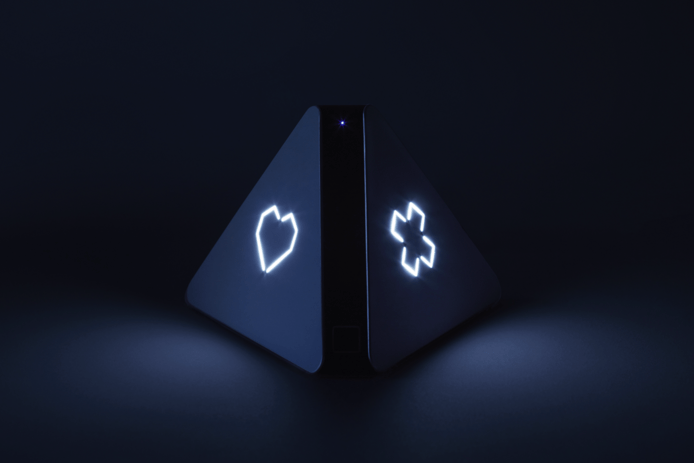
The Prizm works by melding a host of technologies into a singular, adaptive interface. Constructed into a minimalist pyramid, the device connects to any powered speaker system via Bluetooth, 3.5mm, or Optical digital output. The system runs a Linux based OS, and its algorithm is based partly in the device itself, and partly in the cloud, automatically sourcing music over Wi-Fi directly from Spotify, Soundcloud, or Deezer. But that’s just the start of this little silver box’s bag of tricks.
While connected to your local network, the Prizm can sense any smartphone or wearable with which it has interfaced, in essence, sensing your presence so that it can start playing your favorite music right when you walk in the room. The device learns what you don’t like via the skip button on the side, and adds new songs to your playlist when you touch the heart. Via the controller app for iOS and Android, you can also set the Prizm to wake you in the morning, or fall asleep with you at night. And to keep things fresh, the Prizm is designed to playback a different song each time you rise. But the Prizm goes further.
Using an acoustic sensor to detect the ambience of the room, the Prizm knows if there’s a party going down, and will pump up the jams. If the room is quiet, it senses a calm night in, and slows things down. And thanks to its Wi-Fi and Bluetooth sensors for smartphones, it can also delve deeper, sensing if your significant other or roommate is present, and adjusting the playlist accordingly. The more you interact with the Prizm, the more it discovers about your music habits, growing with you to better express your tastes.
If that all sounds a little bit like big brother — or maybe HAL 9000 — that’s because it is. We’re not alarmists, but let’s just say we wouldn’t want to give this little box the keys to the nuclear arsenal just yet. But jokes aside, if the Prizm really works (and that’s a big “if” when it comes to smart devices), it might just be one of the most intuitive musical companions on the market. And perhaps most impressively, it’s pretty damned affordable too.
The project is already funded, but at the time of publication, there were still plenty of Prizms left on Kickstarter at the $119 Early Bird price point. From there it goes up to $129 for faster delivery, and $199 for two of them. The Prizm is expected to launch in June of next year, and with 31 days left, the device is only around $30,000 shy of its first stretch goal, which will make available a rainbow of color choices. Unfortunately, Scarlett Johansson’s voice is not an option.
We’re certainly not convinced the Prizm will deliver on all its promises, but we’re very intrigued, and hope to get our hands on one soon to give the system a test drive. You can order your own Prizm now from the Kickstarter page — just make sure you don’t give it control of the pod bay doors.


